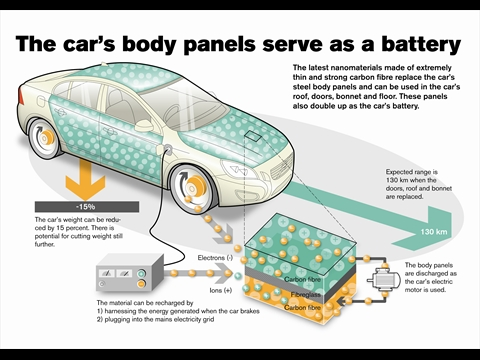
The materials development project launched by Imperial College, London, earlier this year brings together 9 European companies and institutes. Volvo Cars is the only car manufacturer in the project.
With the help of approximately €3.4 million from the European Union (EU), the researchers are developing a composite of carbon fibres and polymer resin that will store and discharge large amounts of energy much quicker than conventional batteries. In addition, the composite material does not use chemical processes, making it quicker to recharge than conventional batteries. The researchers say that the recharging process causes little degradation in the composite material, whereas conventional batteries degrade over time.
The composite material could be charged by plugging a hybrid car into a household power supply. The project is also exploring other alternatives for charging it, such as recycling the energy created when the car brakes.
The material is also extremely strong and pliant, which means it can be shaped for use in building the car's body panels. According to calculations, the car's weight could be cut by as much as 15% if steel body panels were replaced with the new material. One of the biggest challenges in the development of hybrids and electric cars is the size, weight and cost of current batteries. In order to deliver sufficient capacity using today's technology, it is necessary to fit large batteries, which increase the car's weight.
The project will last 3 years. In the first stage of the project, the project team will develop the composite material so that it can store more energy. The team aims to improve the material’s mechanical properties by growing carbon nanotubes on the surface of the carbon fibres. This should also increase the surface area of the material, which would improve its capacity to store more energy. The most effective method for manufacturing the composite material at an industrial level will also be investigated.
In the final stage of the project the battery will be fitted into a car.
"Our role is to contribute expertise on how this technology can be integrated in the future and to input ideas about the advantages and disadvantages in terms of cost and user-friendliness," says Per-Ivar Sellergren, development engineer at the Volvo Cars Materials Centre.
Initially, the composite material will be used to replace the metal flooring in the car boot (the wheel well) which holds the spare wheel. Volvo is investigating the possibility of fitting this wheel well component into prototype cars for testing purposes.
"This is a relatively large structure that is easy to replace," explains Sellergren. "Not sufficiently large to power the entire car, but enough to switch the engine off and on when the car is at a standstill, for instance at traffic lights."
The team says replacing a metal wheel well with a composite one could enable Volvo to reduce the number of batteries needed to power the electric motor. They believe this could lead to a 15% reduction in the car’s overall weight, which should significantly improve the range of future hybrid cars.
Further applications
The researchers believe the material, which has been patented by Imperial College, could potentially be used for the casings of many everyday objects such as mobile phones and computers, so that they would not need a separate battery. This would make such devices smaller, more lightweight and more portable.
The project co-ordinator, Dr Emile Greenhalgh, from the Department of Aeronautics at Imperial College London, says: “We are really excited about the potential of this new technology. We think the car of the future could be drawing power from its roof, its bonnet or even the door, thanks to our new composite material. Even the Sat Nav could be powered by its own casing. The future applications for this material don’t stop there – you might have a mobile phone that is as thin as a credit card because it no longer needs a bulky battery, or a laptop that can draw energy from its casing so it can run for a longer time without recharging. We’re at the first stage of this project and there is a long way to go, but we think our composite material shows real promise.”
Project partners
The other participants in the 3-year project are Swerea SICOMP, INASCO Hella, Chalmers, Advanced Composites Group, Nanocyl, Bundesanstalt Fur Material forschung undprufung, ETC Battery and Fuel Cells Sweden.
Watch the video
Dr Emile Greenhalgh, from the Department of Aeronautics, Imperial College, explains how the composite material works and the benefits of using this material in vehicle manufacture in the YouTube video Car of the future powered by bodywork.






